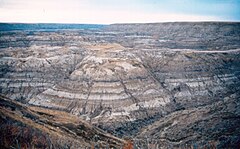| Edmonton Group | |
|---|---|
| Stratigraphic range: | |
 Horseshoe Canyon Formation of the Edmonton Group | |
| Type | Geological group |
| Sub-units | Scollard Formation, Battle Formation, Whitemud Formation, Horseshoe Canyon Formation |
| Underlies | Paskapoo Formation |
| Overlies | Bearpaw Formation, Belly River Group |
| Thickness | 328 metres (1,076 ft) to 763 metres (2,503 ft)[1] |
| Lithology | |
| Primary | Sandstone, shale |
| Other | Bentonite, coal |
| Location | |
| Region | Alberta |
| Country | Canada |
| Type section | |
| Named for | Edmonton |
| Named by | Joseph Tyrrell, 1887 |
Within the earth science of geology, the Edmonton Group is a Late Cretaceous (Campanian stage) to early Paleocene stratigraphic unit of the Western Canada Sedimentary Basin in the central Alberta plains.[2] It was first described as the Edmonton Formation by Joseph Burr Tyrrell in 1887 based on outcrops along the North Saskatchewan River in and near the city of Edmonton.[3] E.J.W. Irish later elevated the formation to group status and it was subdivided into four separate formations.[4] In ascending order, they are the Horseshoe Canyon, Whitemud, Battle and Scollard Formations.[2][1] The Cretaceous-Paleogene boundary occurs within the Scollard Formation, based on dinosaurian and microfloral evidence,[5] as well as the presence of the terminal Cretaceous iridium anomaly.[6]
- ^ a b Cite error: The named reference
CSPG_Lexiconwas invoked but never defined (see the help page). - ^ a b Mossop, G.D. and Shetsen, I. (compilers), Canadian Society of Petroleum Geologists (1994). "The Geological Atlas of the Western Canada Sedimentary Basin, Chapter 24: Upper Cretaceous and Tertiary strata of the Western Canada Sedimentary Basin". Retrieved 2016-06-20.
{{cite web}}: CS1 maint: multiple names: authors list (link) - ^ Tyrrell, J.B., 1887. Report on a part of northern Alberta and portions of adjacent Districts of Assiniboia and Saskatchewan. Geological Survey of Canada, Ann. Rept.1886, new ser., v.11, Part E, p.1-176.
- ^ Irish, E.J.W. 1970. The Edmonton Group of south-central Alberta. Bulletin of Canadian Petroleum Geology, vol. 18, p. 125-155.
- ^ Lerbekmo, J.F., Singh, C., Jarzen, D.M., and Russel, D.A. 1979. The Cretaceous-Tertiary boundary in south-central Alberta - a revision based on dinosaurian and microfloral evidence. Canadian Journal of Earth Science, 16: 325-330.
- ^ Lerbekmo, J.F. and St. Louis, R.M. 1985. The terminal Cretaceous iridium anomaly in the Red Deer Valley, Alberta. Canadian Journal of Earth Science, 23: 120-124.